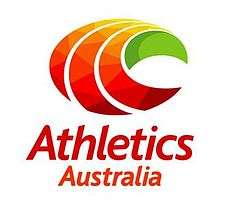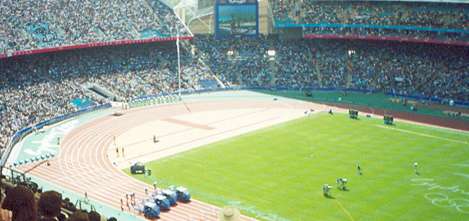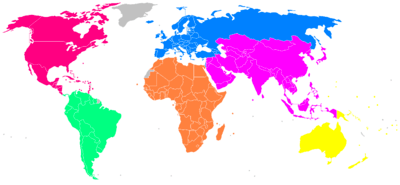Athletics Australia
 | |
| Sport | Athletics |
|---|---|
| Jurisdiction | Australia |
| Abbreviation | AA |
| Founded |
1897 (as Australia Amateur Athletic Association) 1989 (as Athletics Australia) |
| Affiliation | IAAF |
| Regional affiliation | OAA |
| Headquarters | Albert Park, Victoria |
| President | Mark Arbib |
| Chief Exec | Darren Gocher |
| Official website | |
|
www | |
|
| |

Athletics Australia is the National Sporting Organisation (NSO) recognised by the Australian Sports Commission for the sport of athletics in Australia.[2]
First founded in 1897, the organisation is responsible for administering a sport with over 16,000 registered athletes, coaches and officials.[3]
History
Athletics Australia (AA) was originally the Athletic Union of Australasia, an amateur group founded in 1897. In 1928, New Zealand broke away to form its own national body and the Amateur Athletics Union of Australia (AAU) was the result.
In 1932, an Australian Women's Amateur Athletics Union (AWAAU) was instituted and it remained responsible for women's athletics until 1978. In that year, the separate national unions amalgamated into one governing body which, in 1989, was rebranded as Athletics Australia.[4]
Overview
Affiliated with the IAAF, the organisation governs the sport of athletics throughout Australia, conducting a range of important competitions each year.
AA conducts the Athletics Grand Prix Series and the Australian Championships in Athletics,[5] where athletes compete to gain selection at Olympic Games, Commonwealth Games and World Championships.[6] The Australian Athletics Team since 2009 has been known as the Australian Flame. [7]
The association also provides co-ordination, guidance, and support to affiliated member organisations, which govern athletics in their respective states, territories or jurisdictions (e.g. Paralympic athletics).[8]
A number of committees and commissions hold responsibilities in specialist areas such as Race walking, Coaching and Anti-doping.[9]
Organisational Goals
Athletics Australia (AA) is responsible for achieving a number of key strategies, including:[3]
- Ensuring financial stability
- Supporting high-performance around Australia
- The development of athletes, coaches and officials
The organisation has set a goal to finish in the top-ten countries competing in athletics at the 2012 London Olympics, winning five medals and achieving fourteen top-eight placings.[10]
Hall of Fame
In 2000 Athletics Australia established its Hall of Fame to recognise outstanding achievement amongst Australia's greatest athletes. Induction is at the discretion of Athletics Australia's Special Awards Committee.[11]
- Edwin Flack (2000)
- Shirley Strickland (2000)
- Marjorie Jackson (2000)
- Betty Cuthbert (2000)
- Herb Elliott (2000)
- Ron Clarke (2000)
- Nick Winter (2004)
- John Landy (2004)
- Raelene Boyle (2004)
- Ralph Doubell (2004)
- (Francois) Robert De Castella (2008)
- Debbie Flintoff-King (2008)
- Decima Norman (2008)
- John Winter (2008)
- Pam (Kilborn) Ryan (2008)
- Catherine Freeman (2009)
- Glynis Nunn-Cearns (2009)
- June Ferguson (2009)
- Maureen Caird (2009)
- Stanley Rowley (2009)
- Peter Norman (2010)
- Marlene Matthews (2010)
- David Power (2010)
- Henri Schubert (2010)
- Jack Metcalfe (2010)
- Michele Mason Brown (2010)
- Brenda Jones-Carr (2011)
- Charles 'Chilla' Porter (2011)
- Judy Amoore-Pollock (2011)
- Percy Cerutty (2011)
- Richard 'Rick' Mitchell (2011)
- Noel Freeman (2012)
- Dmitri Markov (2012)
- Kerry Saxby-Junna (2012)
- Gary Honey (2013)
- Norma Thrower (2013)
- Louise Currey (2013)
- Franz Stampfl (2013)
- Darren Clark (2014)
- Lisa Ondieki (2014)
- Jennifer Lamy (2014)
- Louise Sauvage (2014)
- Steve Moneghetti (2016)
- Tatiana Grigorieva (2016)
- Marilyn Black (2016)
- Benita Willis (2017) [12].
See also
References
- ↑ Athletics Australia - Australia at the 2000 Games Archived July 18, 2012, at Archive.is
- ↑ Cool Running Australia
- 1 2 - Athletics Australia - Annual Report 2006/07 Archived December 30, 2012, at Archive.is
- ↑ Athletics Australia - History Archived October 5, 2009, at the Portuguese Web Archive
- ↑ Athletics Australia - Season Guide 2007/08 Archived February 25, 2008, at the Wayback Machine.
- ↑ Athletics Australia - General Selection Criteria Archived April 26, 2008, at the Wayback Machine.
- ↑ Athletics Australia (2010). Annual report 2009-2010 (PDF). Melbourne: Athletics Australia. Retrieved 8 September 2015.
- ↑ Athletics Australia - Affiliated Organisations Archived February 27, 2008, at the Wayback Machine.
- ↑ Athletics Australia - Commissions and Committees Archived October 5, 2009, at the Portuguese Web Archive
- ↑ Athletics Australia - Achieving High Performance 2005-2009 Archived October 6, 2009, at the Portuguese Web Archive
- ↑ "Athletics Australia Hall of Fame". athletics.com.au. Athletics Australia. Retrieved 13 June 2015.
- ↑ "This year's Hall of Fame inductee is @BenitaWillis". Athletiucs Australia Twitter. Retrieved 18 February 2018.
